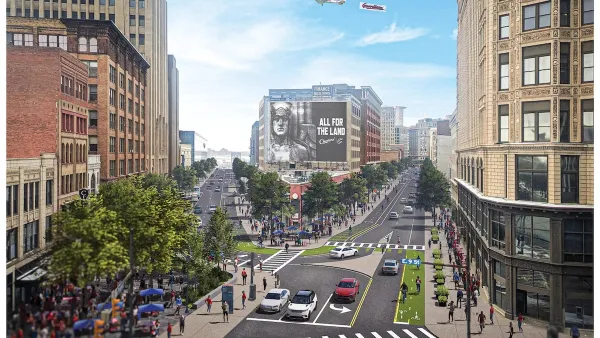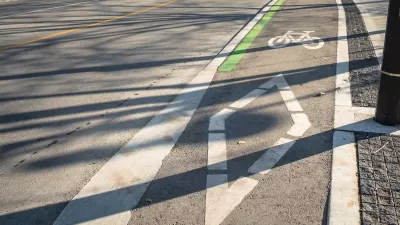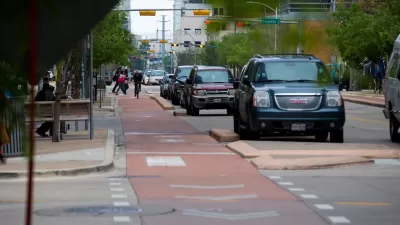A photo of a "backwards" buffered bike lane in Cleveland prompts commentary from the planning community. What is gained by separating bike lane and curb?

Cleveland is experimenting with an interesting design for bike lanes, one where a marked buffer lies not between bikes and vehicles, but between bikes and curb. Please see the article for a photo of the actual situation in Cleveland. It differs a lot from the usual buffered lane. From the article by Michael Andersen: "If you've got at least two feet of roadway to spare, you lay down some hash marks between car and bike lanes and double the comfort of biking on a street."
Nathan Wilkes of the Austin transportation department remarked, "The only use I have seen as shown in the photo is if there were parked cars to the right of the bicycle lane where there was more concern about the door zone than the moving traffic. In short it looks to be a waste of buffer material applied incorrectly."
Cleveland engineers argued that their design reduces the chance of cars turning right in front of bikes. Other reasons for the curious design might include using the wind from passing trucks to clear debris, or to make plowing snow easier.
FULL STORY: ‘Seems to be in the wrong place’: Peers react to Cleveland’s unusual bike lane

Planetizen Federal Action Tracker
A weekly monitor of how Trump’s orders and actions are impacting planners and planning in America.

San Francisco's School District Spent $105M To Build Affordable Housing for Teachers — And That's Just the Beginning
SFUSD joins a growing list of school districts using their land holdings to address housing affordability challenges faced by their own employees.

The Tiny, Adorable $7,000 Car Turning Japan Onto EVs
The single seat Mibot charges from a regular plug as quickly as an iPad, and is about half the price of an average EV.

Seattle's Plan for Adopting Driverless Cars
Equity, safety, accessibility and affordability are front of mind as the city prepares for robotaxis and other autonomous vehicles.

As Trump Phases Out FEMA, Is It Time to Flee the Floodplains?
With less federal funding available for disaster relief efforts, the need to relocate at-risk communities is more urgent than ever.

With Protected Lanes, 460% More People Commute by Bike
For those needing more ammo, more data proving what we already knew is here.
Urban Design for Planners 1: Software Tools
This six-course series explores essential urban design concepts using open source software and equips planners with the tools they need to participate fully in the urban design process.
Planning for Universal Design
Learn the tools for implementing Universal Design in planning regulations.
Smith Gee Studio
City of Charlotte
City of Camden Redevelopment Agency
City of Astoria
Transportation Research & Education Center (TREC) at Portland State University
US High Speed Rail Association
City of Camden Redevelopment Agency
Municipality of Princeton (NJ)





























